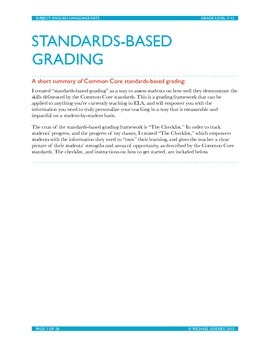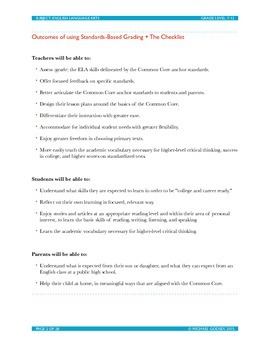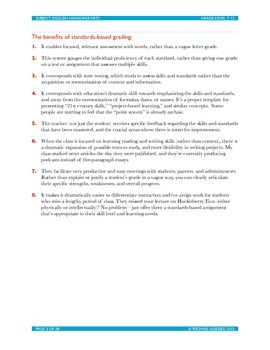Standards-Based Grading | Master CCSS Aligned ELA Grading Framework
Mike and Melissa Godsey
581 Followers
Grade Levels
7th - 12th
Resource Type
Standards
CCSSCCRA.R.1
CCSSCCRA.R.2
CCSSCCRA.R.3
CCSSCCRA.R.4
CCSSCCRA.R.5
Formats Included
- PDF
Pages
28 pages
Mike and Melissa Godsey
581 Followers
Description
"Standards-based Grading" is primarily a rubric for all 32 ELA Common Core Anchor Standards, written in a language that students (and parents) can understand, and scaffolded for all levels of proficiency.
This unit contains "The Checklist," which is a template that articulates all 32 anchor standards, facilitates standards-based grading, allows students to self-reflect on their own academic growth, and significantly helps teachers design lesson plans that are based on the Common Core. "The Checklist" also helps facilitate easy, meaningful, and relevant conversations with students and parents regarding student progress.
This unit also includes ideas on how to use standards-based learning in your classroom, and plenty of reasons why this modern form of assessment is superior to traditional models (in case you want to explain your shift to your administration or other teachers).
In total, the entire packet is a starter kit for any educator who is interested in standards-based grading. I've used it in presentations to two different school districts, and I strongly believe it will help you design a more efficient, student-centered classroom.
This unit contains "The Checklist," which is a template that articulates all 32 anchor standards, facilitates standards-based grading, allows students to self-reflect on their own academic growth, and significantly helps teachers design lesson plans that are based on the Common Core. "The Checklist" also helps facilitate easy, meaningful, and relevant conversations with students and parents regarding student progress.
This unit also includes ideas on how to use standards-based learning in your classroom, and plenty of reasons why this modern form of assessment is superior to traditional models (in case you want to explain your shift to your administration or other teachers).
In total, the entire packet is a starter kit for any educator who is interested in standards-based grading. I've used it in presentations to two different school districts, and I strongly believe it will help you design a more efficient, student-centered classroom.
Total Pages
28 pages
Answer Key
Included with rubric
Teaching Duration
Lifelong tool
Report this resource to TPT
Reported resources will be reviewed by our team. Report this resource to let us know if this resource violates TPT’s content guidelines.
Standards
to see state-specific standards (only available in the US).
CCSSCCRA.R.1
Read closely to determine what the text says explicitly and to make logical inferences from it; cite specific textual evidence when writing or speaking to support conclusions drawn from the text.
CCSSCCRA.R.2
Determine central ideas or themes of a text and analyze their development; summarize the key supporting details and ideas.
CCSSCCRA.R.3
Analyze how and why individuals, events, and ideas develop and interact over the course of a text.
CCSSCCRA.R.4
Interpret words and phrases as they are used in a text, including determining technical, connotative, and figurative meanings, and analyze how specific word choices shape meaning or tone.
CCSSCCRA.R.5
Analyze the structure of texts, including how specific sentences, paragraphs, and larger portions of the text (e.g., a section, chapter, scene, or stanza) relate to each other and the whole.





